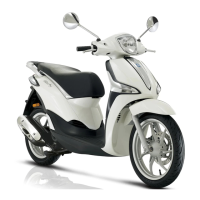
Do you have a question about the PIAGGIO Liberty 50 Catalyzed 2019 and is the answer not in the manual?
| Engine Type | Single-cylinder, 4-stroke |
|---|---|
| Engine Stroke | 4-stroke |
| Cooling | Air cooled |
| Transmission | Automatic CVT |
| Seat Height | 780 mm |
| Fuel Tank Capacity | 6.0 liters |
| Rear Suspension | Single shock absorber |
| Front Suspension | Telescopic fork |
| Wheelbase | 1, 340 mm |
| Power | 7, 500 rpm |
| Fuel System | Electronic injection |
| Weight | 98 kg |
| Brakes Front | Disc brake |
| Brakes Rear | Drum |
| Tires Rear | 100/80-14 |
Overview of the scooter's dashboard indicators, gauges, and controls for primary operation.
Instructions for viewing and adjusting the digital clock on the instrument panel.
Details on using the keyswitch and locking the steering wheel for security and starting.
Explanation of turn indicator and horn button operation for safe riding.
Instructions for operating the light switch and starter button for vehicle operation.
Steps to open the saddle and information about the vehicle's keys for access.
Location and importance of vehicle identification numbers (chassis and engine) for parts and registration.
How to open the rear top box or glove-box compartment for storage.
Instructions for using the retractable bag hook located on the saddle.
Essential checks to perform before riding the vehicle to ensure safety and functionality.
Guide to filling the fuel tank and topping up the oil reservoir correctly.
Recommended tyre pressures for front and rear wheels, and wear limits.
Guidelines for the initial running-in period of the engine for optimal longevity.
Step-by-step instructions for starting the scooter's engine.
Solutions for common engine start-up problems like flooding or battery issues.
How to properly stop the scooter's engine.
Important warnings and precautions regarding the catalytic silencer's high temperatures.
Explanation of the automatic transmission system and its operating characteristics.
Essential tips and precautions for safe and responsible vehicle operation.
Procedure for checking and maintaining the oil level in the rear hub.
Guidelines for checking tyre wear indicators and when to replace tyres.
Instructions for removing, refitting, and checking the spark plug.
Procedures for removing and cleaning the vehicle's air filter element.
Instructions for cleaning and maintaining the secondary air system components.
Guidance on cleaning and refitting the intake plug.
How to check the brake fluid level and important fluid handling precautions.
Guidance on accessing, maintaining, and storing the vehicle battery for optimal performance.
Information on the fuse location, rating, and replacement procedure.
Steps to access and service the front headlight bulbs.
Procedure for adjusting the headlight beam for optimal visibility and road legality.
How to replace front turn indicator bulbs.
Instructions for accessing and servicing the rear tail light and turn indicator bulbs.
Guide to adjusting the rear-view mirrors for optimal rearward visibility.
Procedure for adjusting the engine's idle speed for smooth operation.
Information on front disc brake pad wear and when to seek service.
How to adjust the rear drum brake for proper function.
Advice on handling tubeless tyre punctures and repair options.
Steps for preparing the vehicle for extended periods of non-use.
Recommended methods for cleaning the scooter to maintain its condition.
Detailed technical data regarding the engine, including capacity, bore, and compression.
Overview of overall vehicle dimensions, fuel, cooling, transmission, and frame details.
Technical details for front and rear brakes, wheel rims, and tyre sizes.
Listing of tools included in the vehicle's toolkit and their location.
Recommendations for using original Piaggio parts and accessories for safety and warranty.
A table outlining recommended maintenance checks and services at specific mileage intervals.
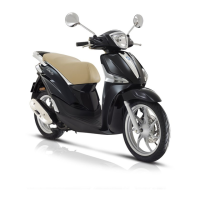

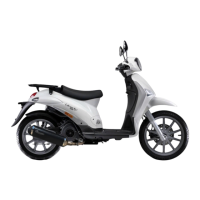
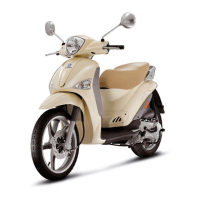
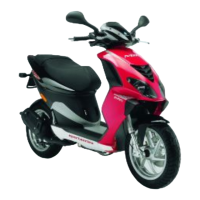
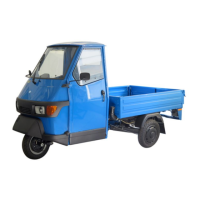
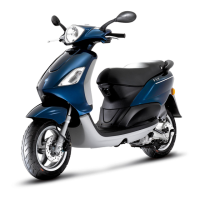
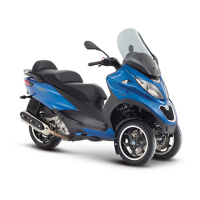

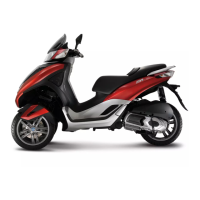
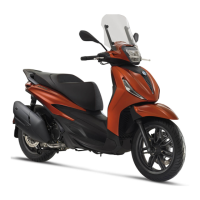

